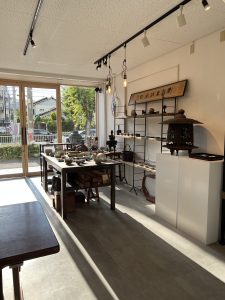今年の冬は、お天気のことわざの真偽を確かめてみることにしようかと。(愛知県名古屋市千種区姫池通 骨董買取 古美術風光舎)
2023.10.19
みなさまこんにちは、スタッフYでございます。

先日、お知り合いの方から早くも柿を頂きました。実りの秋だなあ…と、呟きながらしみじみあのオレンジ色、いえいえ柿色を眺めておりました。果実には表作、裏作があるといいますが、今年は柿が表作のようでして、どうやらたくさんなる年のようであります。昨日も奈良へいってまいりましたが、確かにたわわに実った柿の木をたくさん目に致しました。
それにしても、奈良の寺院の風景と柿の木は本当によく似合います。
正岡子規のあの有名な句
「柿食えば 鐘が鳴るなり 法隆寺(ほうりゅうじ)」
ではないですが、あの奈良のお寺さんと柿の木の風景を眺めて、何も歌わぬ俳人はいないではないか。想像ではありますが、かの子規も、思わずその風景をなぞりながら思わずあの句が口から溢れ出たのではないかと思います。

そのせいでしょうが、今年はそんな柿を求めて民家への熊の出没情報の多い地域もあるようでして。その地域の皆さまは心配もおありかと思います。熊に遭遇するのはやはり怖いですよね。
そういえば、昨年一緒に山歩きにでかけた際に同行した姪っ子がYouTubeで検索した熊鈴の音源を携帯で鳴らしながら歩いていたことを思い出しましたので、熊鈴を持ちあわせてない方はちょっとおすすめであります。
柿の話に戻りますが、「柿の実の多い年は寒気激しい」という柿にちなんだお天気のことわざがあるのですが、本当なのでしょうか。
柿の実は、結実初期が梅雨の頃になるので、梅雨に雨風が多い年は落果が多くなり秋の収穫期には実が少なくなり、梅雨に雨風が少ない年には落果が少なく秋に実が多く残るようです。 すると、梅雨に雨の少ない年は秋には冷え込んだり、寒暖の差が激しい年になったりするのかもしれないということなのですが 本当のような嘘のような。
この諺が意味する事の真偽はよく分からないようですが、この真偽をここ数年ちょっと確認してみたくなりました。そんなわけでついでに「お天気のことわざ」他にもあるのか冬に限って調べてみましたら、まあまあありました。いくつかご紹介いたしましょう。
「鳥が高いところに巣をつくれば大雪」
雪に埋もれる程低いところに鳥が巣を作るとは思えないのですが、もし鳥が大雪になることを察知して、より高いところへと巣をつくるのなら、それは明日や明後日のような短期予報ではなく、中・長期予報が出来ることになのではということのようであります。 信じがたい事ではあるが、カマキリが積雪高さを予知して卵の高さを変えているという研究データも報告されているので、自然の動植物にはそれらを知る能力が備わっているのでしょうか。 今後、その仕組みが解明されれば、人間社会の中期予報ももっと精度よく予報することができるようになったりして笑。個人的にはちょっと期待したいところですね。
「ガンの行列、南へ行けば寒気強し」
ガンは暖かい地域に住む渡り鳥。ですから、秋から冬にかけて、ガンが南へ向かって隊列をつくり渡っているときは、北に強い寒気が迫ってきているという事を暗示していることからのようですが、ガンはちょっと観察するのは自分の地域では難しいので確認が難しいか…。
「カモが早く来ると早雪」
と、いうことわざもあるのですが、こちらも自分の地域ではカモ確認が難しい。その理由は、カモは渡り鳥であり、夏には北方の寒冷地で産卵・子育てをして冬になると日本へ渡ってきますが、カモは9月下旬頃から日本へ上陸し、しだいに南下していきます。が、その時期が早い年は例年より寒気が下りてくるのが早く、初雪が早く見られる可能性があることを示唆しているようです。
「大根の根が長い年は寒い」
ご存知のように大根の白い部分は根っこ。地中で育っています。このため、大根の生育と地中温度とには密接な関係があるようです。一般的に地温の低い地域で育った大根は細く、地温の高い地域で育った大根は太くなります。 そして、一般的に地下深くほど温度が一定しており、気温が寒い年は熱を求めて地下深くまで伸びてしまい、逆に暖かい年は太く短くなる傾向があります。 ただし大根に限っては、残念ながらこの諺は「結果」を表しているのであって、残念ながら「予知」や「予報」などの真偽はできませんね。
「ソバの豊作は大雪」
植物のソバは夏に寒冷な地域で育ちます。日本ではイネが育ちにくい寒冷な地域で育てられ、主食として栽培されてきましたのですが、 夏に育つ作物なのでこの諺は予言のようですが、実際には当たっているようで当たっていないような諺だそうです。 どちらかと言うとソバが豊作になると、ソバの白い花が雪が積もったようにたくさん咲くことから大雪を連想させるのではないかと思われますから、これは真偽とまではいかないでしょうか笑。
その他にも、「カメムシが大発生する年は大雪になる」とか、「鳥が高いところに巣をつくれば大雪」などなど、いろいろ言われておりますが、ここ数年その真偽を確認してみたくなりましたので、忘れずに注意深く過ごしてみようと思っておりますが、一番心配なことは、当の本人が忘れてしまいそうなことでしょうか…。
それではごきげんよう。
Hello everyone, this is Staff Y.
The other day, we received some persimmons from a friend of ours. I was looking at the orange, or rather, persimmon color while muttering to myself, “It’s the harvest season…”. It is said that there is a front crop and a back crop of persimmons, and this year seems to be a front crop, with lots of persimmons. I went to Nara yesterday and saw many persimmon trees with abundant fruits.
The scenery of temples and persimmon trees in Nara really go well together.
It is not Shiki Masaoka’s famous haiku, “If you eat a persimmon, the bell will ring, Horyu-ji Temple. Although it is my imagination, I believe that even Shiki may have unintentionally traced the scenery and had his haiku overflowing from his mouth.
Perhaps this is the reason why there are many reports of bears visiting homes in search of persimmons in some areas this year. I am sure people in those areas are worried about bears. It is still scary to encounter a bear, isn’t it?
Come to think of it, I remember that my niece who accompanied me on a hiking trip last year was walking with me while ringing a bear bell on her cell phone, which she found on YouTube.
Back to persimmons, there is a weather proverb associated with persimmons, “A year with many persimmon fruits is a year of intense cold.
Since persimmon fruits are in the early stages of fruiting during the rainy season, it seems that in years when there is a lot of rain and wind during the rainy season, more fruits fall and there are fewer fruits during the fall harvest season, and in years when there is little rain and wind during the rainy season, fewer fruits fall and more fruits remain in the fall. Then, it means that a year with little rainfall in the rainy season may be a year with cooler temperatures in the fall, or a year with a large difference in temperature between cold and warm.
The truth of what this proverb means seems to be unclear, but I wanted to check the truth of this saying for the past few years.
So I looked up “weather proverbs” only for winter to see if there were any other proverbs about the weather. Here are some of them.
If a bird nests too high, it snows too much.
It is hard to believe that birds would build their nests so low that they would be buried in snow, but if birds can sense that there will be heavy snow and build their nests higher, it would mean that they can make medium- to long-term forecasts, not short-term forecasts like tomorrow or the day after tomorrow. It is hard to believe, but research data has shown that praying mantis predict the height of snow accumulation and change the height of their eggs. If the mechanism is clarified in the future, it may become possible to forecast the mid-term forecast of human society with more accuracy, lol. Personally, I have a bit of hope for that.
“Geese are migratory birds that live in warmer areas.
Geese are migratory birds that live in warm regions. Therefore, when geese form a procession to the south in autumn and winter, it seems to imply that a strong cold spell is approaching in the north, but it is difficult to observe geese in my area, so it may be difficult to confirm this….
The saying goes, “If the ducks come early, it snows early.”
but it is also difficult to confirm ducks in my area. The reason for this is that ducks are migratory birds, which lay eggs and raise their young in the cold northern regions in the summer and come to Japan in the winter. The ducks land in Japan around the end of September and gradually move south, but the earlier the season, the earlier the cold air arrives and the earlier the first snow may be seen.
Years with long daikon radish roots are cold.
As you know, the white part of daikon is the root. They grow underground. Therefore, there seems to be a close relationship between the growth of daikon and the underground temperature. Generally, daikon grown in areas with low soil temperatures are thinner, while daikon grown in areas with high soil temperatures are thicker. And in general, the deeper underground, the more constant the temperature is. In cold years, radishes tend to grow deeper underground in search of heat, while in warmer years, they tend to grow thicker and shorter. Unfortunately, however, as far as daikon is concerned, the proverb refers to “results,” and unfortunately, it cannot be true of “prediction” or “forecast,” can it?
A good buckwheat crop means heavy snowfall.”
The plant buckwheat grows in cold regions in summer. In Japan, buckwheat is grown in cold regions where it is difficult for rice to grow, and has been cultivated as a staple food. If anything, a good buckwheat crop may be associated with a heavy snowfall, since buckwheat’s white flowers bloom in profusion as if covered with snow, so this may not even be true or false.
I have been trying to confirm the truth of this saying for a few years now, and I will try to remember it and be careful, but what worries me the most is that I might forget it. The most worrisome thing is that the person himself might forget….
I will try to remember to be very careful.
*******************
ご実家の整理やお片付けなどをされている方のご相談などが多くございます。
お片付けなどくれぐれもご無理のないようになさってくださいませ。
風光舎では古美術品や骨董品の他にも絵画や宝石、趣味のお品など様々なジャンルのものを買受しております。
お片付けをされていて、こういうものでもいいのかしらと迷われているものでも、どうぞお気軽にご相談下さいませ。
また風光舎は、出張買取も強化しております。ご近所はもちろん、愛知県内、岐阜県、三重県その他の県へも出張いたします。
まずは、お電話お待ちしております。
愛知県名古屋市千種区姫池通
骨董 買取【古美術 風光舎 名古屋店】
TEL052(734)8444
10:00-17:00 OPEN
#出張買取#骨董#古美術#骨董品#絵画#版画#茶道具#刀剣#彫刻

